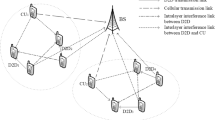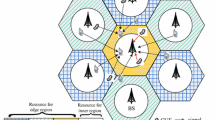Abstract
A distributed resource allocation algorithm that combines the spectrum allocation and the power control is proposed to solve the problem of the throughput maximization in device-to device (D2D) communication systems. The problem is modeled by a distributed algorithm, where a new utility function is presented, and the constraints in the utility function will reduce the interference between users. Following the maximum of the data rate of cellular users with water-filling algorithm, the resource allocation and power control for D2D are solved by noncooperative game. The existence and uniqueness of Nash equilibrium of the proposed algorithm are proved. The simulation results show that the proposed algorithm can improve the throughput of the D2D underlaying communication system.



Similar content being viewed by others
Data Availability
The data or code used to support the findings of this study are available from the corresponding author upon request.
References
Doppler, K., Rinne, M., et al. (2009). Device-to-device communication as an underlay to LTE-advanced networks. IEEE Communications Magazine, 47(12), 42–49.
Fitzek, F. H., Katz, M., & Zhang, Q. (2009). Cellular controlled short-range communication for cooperative P2P networking. Kluwer Academic Publishers.
Yu, C.-H., Doppler, K., et al. (2011). Resource sharing optimization for device-to-device communication underlaying cellular networks. IEEE Transactions on Wireless Communications, 10(8), 2752–2763.
Zulhasnine, M., Huang, C., & Srinivasan A (2010). Efficient resource allocation for device-to-device communication underlaying LTE network. In IEEE, International Conference on Wireless and Mobile Computing, NETWORKING and Communications IEEE, pp. 68–375.
Wang, J., Zhu, D., et al. (2013). Resource sharing of underlaying device-to-device and uplink cellular communications. IEEE Communications Letters, 17(6), 1148–1151.
Yin, R., Guanding, Yu., et al. (2015). Pricing-based interference coordination for D2D communications in cellular networks. IEEE Transactions on Wireless Communications, 14(3), 1519–1532.
Yin, R., Zhong, C., et al. (2016). Joint spectrum and power allocation for D2D communications underlaying cellular networks. IEEE Transactions on Vehicular Technology, 65(4), 2182–2195.
Nguyen, H. H., Hasegawa, M., & Hwang, W. J. (2016). Distributed resource allocation for D2D communications underlay cellular networks. IEEE Communications Letters, 20(5), 942–945.
Zhou, Z., Dong, M., et al. (2014). Game-theoretic approach to energy-efficient resource allocation in device-to-device underlay communications. Communications IET, 9(3), 375–385.
Ding, J., Jiang, L., & He, C. (2016). Energy-efficient power control for underlaying D2D communication with channel uncertainty: User-centric versus network-centric. Journal of Communications & Networks, 18(4), 589–599.
Li A., et al. (2015) A distributed energy-efficient algorithm for resource allocation in downlink femtocell networks. In IEEE, International Symposium on Personal, Indoor, and Mobile Radio Communication. pp. 1169–1174.
Han, Z., et al. (2012). Game theory in wireless and communication networks: Theory, models, and applications. Cambridge University Press.
Jiang, Y., Liu, Q., et al. (2017). Energy-efficient joint resource allocation and power control for D2D communications. IEEE Transactions on Vehicular Technology, 65(8), 6119–6127.
Funding
This work was supported by the National Natural Science Foundation of China under Grant 62171345.
Author information
Authors and Affiliations
Corresponding author
Ethics declarations
Conflict of interest
The authors have no conflicts of interest to declare that are relevant to the content of this article.
Additional information
Publisher's Note
Springer Nature remains neutral with regard to jurisdictional claims in published maps and institutional affiliations.
Rights and permissions
About this article
Cite this article
Sun, Y., Chen, Y., Wang, Z. et al. Resource Allocation and Power Control Based on Noncooperative Game for D2D Communications Underlaying Cellular Networks. Wireless Pers Commun 124, 2723–2733 (2022). https://doi.org/10.1007/s11277-022-09486-4
Accepted:
Published:
Issue Date:
DOI: https://doi.org/10.1007/s11277-022-09486-4




